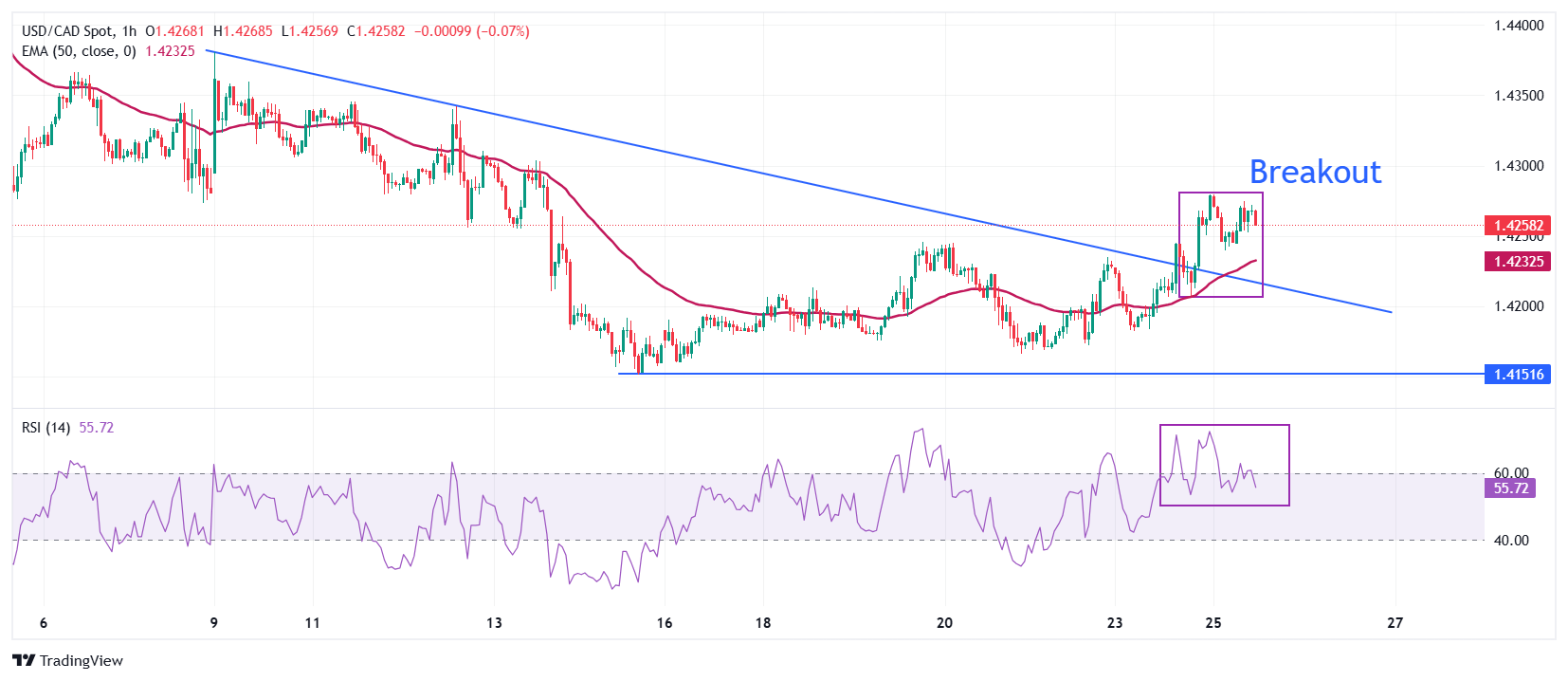USD/CAD Price Forecast: Holds gains around 1.4250
- USD/CAD holds onto gains near 1.4260 amid renewed fears of Trump tariffs on Canada and Mexico.
- Canada’s inflation has remained below BoC’s mandate in the last three months.
- BoC’s Macklem warned that the impact of Trump tariffs could be severe on Canada.
The USD/CAD clings to gains near 1.4260 in European trading hours on Tuesday. The Loonie pair holds on Monday’s recovery move as the US Dollar (USD) steadies after the United States (US) President confirmed that his plans of imposing 25% levies on imports from Canada and Mexico on March 4 are intact.
The US Dollar Index (DXY), which gauges the Greenback’s value against six major currencies, is slightly down but remains around Monday’s recovery move to near 106.70.
President Trump postponed his plans of slapping 25% tariffs on Canada and Mexico on February 4 after both nations agreed to send forces at borders to restrict the flow of fentanyl and undocumented immigrants to the US.
Trump’s tariffs on Canada would weaken its already vulnerable economic outlook. Inflation in the Canadian economy has been undershooting the Bank of Canada’s (BoC) target of 2% for the past three months, suggesting a weak demand environment.
On Friday, BoC Governor Tiff Macklem warned in a speech in Ontario on Friday that the economic impact would be severe if Trump slaps tariffs on all imports from Canada.
USD/CAD breaks out of the Descending Triangle chart pattern formed on an hourly timeframe. The downward-sloping border of the above-mentioned chart pattern was plotted from the February 9 high of 1.4380 and the flat border was placed from the February 14 low of 1.4151.
The 50-period Exponential Moving Average (EMA) slopes higher to near 1.4230, suggesting a bullish near-term trend.
The 14-period Relative Strength Index (RSI) trades above 50.00, which indicates that a bullish momentum is on.
Going forward, an upside move above the February 24 high of 1.4280 will open the door toward the round-level resistance of 1.4300 and the February 9 high of 1.4380.
On the contrary, if the pair breaks below its February 14 low of 1.4151, it will fall to its December 9 low of 1.4094, followed by its December 6 low of 1.4020.
USD/CAD hourly chart

Canadian Dollar FAQs
The key factors driving the Canadian Dollar (CAD) are the level of interest rates set by the Bank of Canada (BoC), the price of Oil, Canada’s largest export, the health of its economy, inflation and the Trade Balance, which is the difference between the value of Canada’s exports versus its imports. Other factors include market sentiment – whether investors are taking on more risky assets (risk-on) or seeking safe-havens (risk-off) – with risk-on being CAD-positive. As its largest trading partner, the health of the US economy is also a key factor influencing the Canadian Dollar.
The Bank of Canada (BoC) has a significant influence on the Canadian Dollar by setting the level of interest rates that banks can lend to one another. This influences the level of interest rates for everyone. The main goal of the BoC is to maintain inflation at 1-3% by adjusting interest rates up or down. Relatively higher interest rates tend to be positive for the CAD. The Bank of Canada can also use quantitative easing and tightening to influence credit conditions, with the former CAD-negative and the latter CAD-positive.
The price of Oil is a key factor impacting the value of the Canadian Dollar. Petroleum is Canada’s biggest export, so Oil price tends to have an immediate impact on the CAD value. Generally, if Oil price rises CAD also goes up, as aggregate demand for the currency increases. The opposite is the case if the price of Oil falls. Higher Oil prices also tend to result in a greater likelihood of a positive Trade Balance, which is also supportive of the CAD.
While inflation had always traditionally been thought of as a negative factor for a currency since it lowers the value of money, the opposite has actually been the case in modern times with the relaxation of cross-border capital controls. Higher inflation tends to lead central banks to put up interest rates which attracts more capital inflows from global investors seeking a lucrative place to keep their money. This increases demand for the local currency, which in Canada’s case is the Canadian Dollar.
Macroeconomic data releases gauge the health of the economy and can have an impact on the Canadian Dollar. Indicators such as GDP, Manufacturing and Services PMIs, employment, and consumer sentiment surveys can all influence the direction of the CAD. A strong economy is good for the Canadian Dollar. Not only does it attract more foreign investment but it may encourage the Bank of Canada to put up interest rates, leading to a stronger currency. If economic data is weak, however, the CAD is likely to fall.

